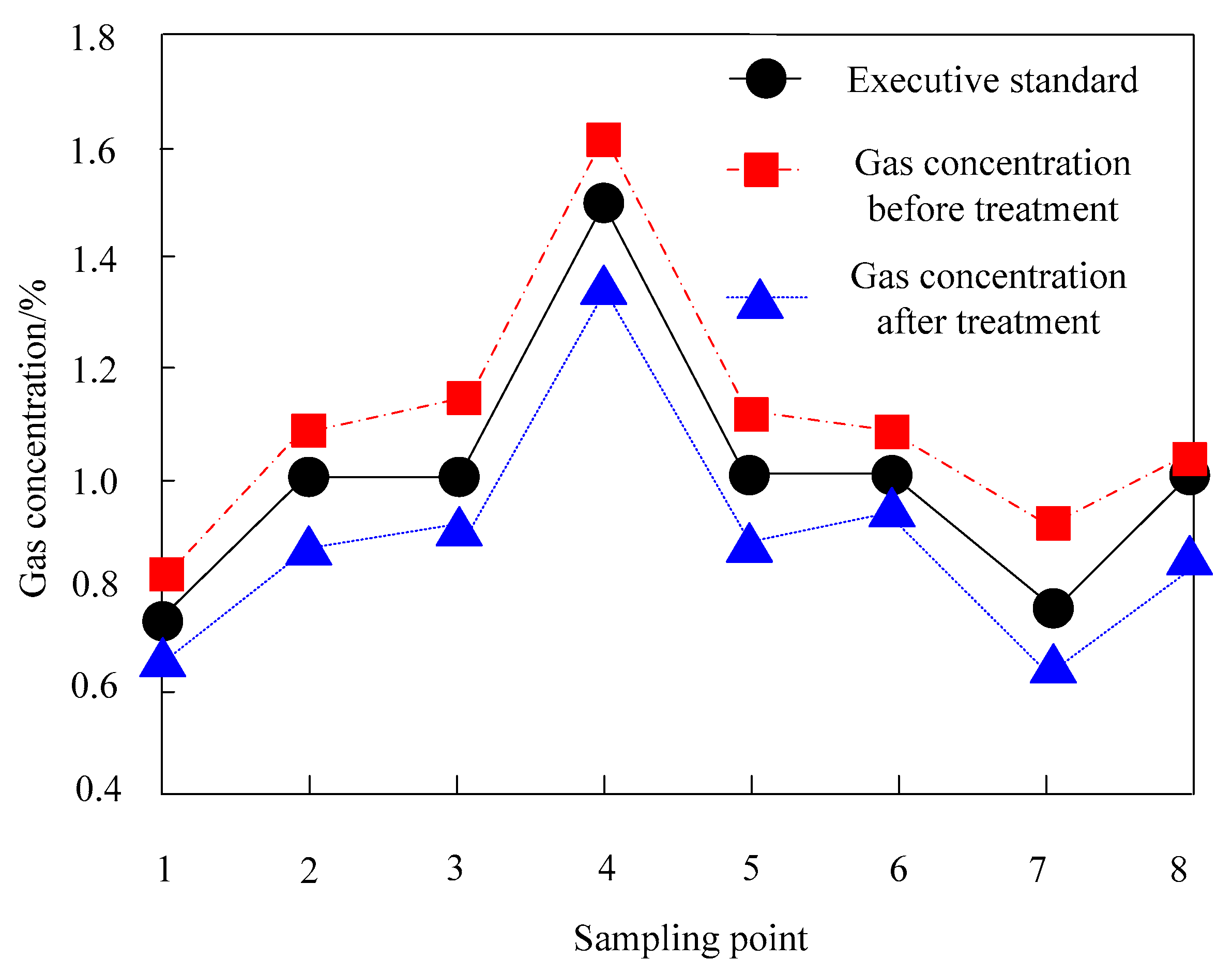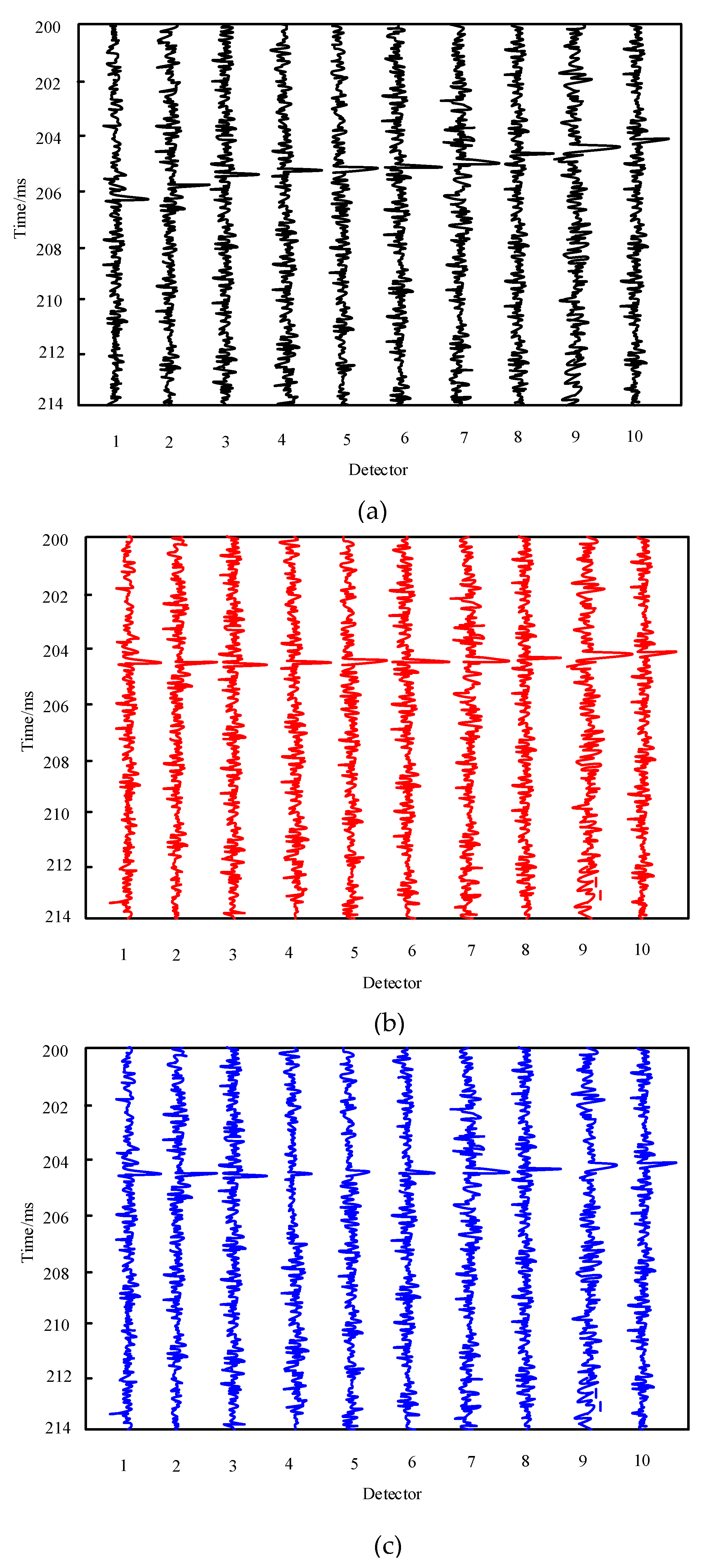Application and Research of Microseismic Monitoring System and Hydraulic Fracturing Technology in Coal Mines
Abstract
1. Introduction
2. Application of Microseismic Monitoring, Hydraulic Fracturing and Other Technologies in Coal Mine Safety Management
2.1. Coal Mine Gas Control Based on Hydraulic Fracturing Technology
- (1)
- Detect the geological conditions and gas concentration of the coal mine;
- (2)
- Determine hydraulic fracturing technical parameters;
- (3)
- Formulate a scientific fracturing plan and strictly implement it.
2.1.1. Geological Structure and Gas Concentration Detection in the Coal Mine Area
2.1.2. Determination of Main Parameters of Hydraulic Fracturing
- (1)
- Water injection pressure of the water pump
- (2)
- Fracturing angle
- (3)
- Borehole spacing
- (4)
- Crack initiation pressure
2.1.3. Implementation of Hydraulic Fracturing Technology
- (1)
- Select technical equipment
- (2)
- Arranging fracturing holes
- (3)
- Preparation of fracturing fluid and sealing material
- (4)
- Grouting and hole sealing
2.2. Hydraulic Fracturing Fracture Monitoring Based on Microseismic Monitoring Technology
2.2.1. Microseismic Signal Acquisition
2.2.2. Automatic Identification of Microseismic Events
2.2.3. Inversion and Location of Microseismic Events
- (1)
- Set the search range and its step size. Centered on the center point of the fracturing well, set according to the actual situation , , search range of direction (i.e., respectively, setting the upper and lower limit of direction search are and , the upper and lower limit of direction search are and , the upper and lower limit of direction search are and ) and the step size , , ;
- (2)
- Input the first break, geophone coordinates, velocity model and initial source coordinates of microseismic events (), order , ;
- (3)
- Build the objective function according to Equation (24) and set the minimum objective function value ;
- (4)
- Polarization analysis is used to constrain the search direction. Calculate the azimuth between the source coordinate and the geophone, that is, the propagation direction of the source (, and are the source and geophone located in the , coordinate difference in direction). Take and the azimuth obtained by polarization analysis of microseismic events for comparison, if ( Indicates the azimuth angle error), then go to the next step ; otherwise order , and on the basis of to judge . If , restart the fourth step; otherwise order , and on the basis of to judge . If , then order , repeat step 4; otherwise, go to step 7;
- (5)
- When , the objective function is solved; otherwise, order , return to step 3;
- (6)
- Find the minimum value of the objective function. Solve the objective function to obtain the value of , compare the value of and the set and assign the smaller of the two to the smallest , and then order , return to step 5;
- (7)
- When , the output objective function is the minimum value, and the corresponding coordinate (optimal solution) is searched, that is, the location of the microseismic event.
3. Experimental Analysis
4. Conclusions
- (1)
- This paper recognizes the importance and necessity of gas control, studies the application of microseismic monitoring, hydraulic fracturing, and other technologies in coal mines, and reviews the problems of high gas content, insufficient permeability of coal seams, and high gas concentration in some coal mines;
- (2)
- In this paper, hydraulic fracturing technology is used to control gas in coal mines, and the fracturing process is monitored by microseismic monitoring technology to evaluate the effect of fracturing. The assessment results are used to understand the actual construction process, to ensure that gas spreads to other coal seams, to dilute the gas concentration, to improve the efficiency of extraction, and to reduce the hazards of gas;
- (3)
- The advantage of this paper is that it is applied to coal mine gas management, which reduces the gas concentration to below the executive standard. Hydraulic fracturing technology can scientifically control the gas and has achieved good management results.
Author Contributions
Funding
Data Availability Statement
Conflicts of Interest
References
- Yan, Z.; Wang, Y.; Fan, J. Research on safety subregion partition method and characterization for coal mine ventilation system. Math. Probl. Eng. 2021, 2021 Pt 17, 5540178.1–5540178.11. [Google Scholar] [CrossRef]
- Wu, D.M.; Zhang, Y.; Zhang, S.Q. Research on Video Smoke Detection in Coal Mine. Comput. Simul. 2021, 38, 446–449+496. [Google Scholar]
- Liu, X.G.; Zhou, J.L. Research on method of determination on coal powder content in gear oil for equipment used in coal mine. Ordnance Mater. Sci. Eng. 2022, 45, 114–118. [Google Scholar]
- Qin, M.; Zhang, Q.; Yue, J. Development and application of coal mine gas geological intelligent early warning system. Basic Clin. Pharmacol. Toxicol. 2021, 128, 45. [Google Scholar]
- Wamriew, D.; Charara, M.; Pissarenko, D. Joint event location and velocity model update in real-time for downhole microseismic monitoring: A deep learning approach. Comput. Geosci. 2022, 158, 104965.1–104965.10. [Google Scholar] [CrossRef]
- Huang, G.; Chen, X.; Saad, O.M.; Chen, Y.; Savvaidis, A.; Fomel, S.; Chen, Y. High-resolution and robust microseismic grouped imaging and grouping strategy analysis. Geophys. Prospect. 2022, 70, 980–1002. [Google Scholar] [CrossRef]
- Park, S.; Choi, Y. Bluetooth beacon-based mine production management application to support ore haulage operations in underground mines. Sustainability 2021, 13, 2281. [Google Scholar] [CrossRef]
- Deng, E.F.; Wang, Y.H.; Liang, Z. Seismic behavior of a novel liftable connection for modular steel buildings: Experimental and numerical studies. Thin-Walled Struct. 2024, 197, 111563. [Google Scholar] [CrossRef]
- Verliac, M.; Calvez, J.L. Microseismic monitoring for reliable c02 injection and storage-geophysical modeling challenges and opportunities. Lead. Edge 2021, 40, 418–423. [Google Scholar] [CrossRef]
- Ahamed, M.A.A.; Perera, S.; Elsworth, D.; Ranjith, P.G.; Li, D.Y. Effective application of proppants during the hydraulic fracturing of coal seam gas reservoirs: Implications from laboratory testings of propped and unpropped coal fractures. Fuel 2021, 304, 121394.1–121394.16. [Google Scholar] [CrossRef]
- Si, L.; Xi, Y.; Wei, J.; Li, B.; Wang, H.; Yao, B.; Liu, Y. Dissolution characteristics of gas in mine water and its application on gas pressure measurement of water-intrusion coal seam. Fuel 2022, 313, 123004.1–123004.11. [Google Scholar] [CrossRef]
- Shi, B.; Cao, Y.; Tian, L.; Zhang, J.; Liu, S. Co_2 gas fracturing in high dip angled coal seams for improved gas drainage efficiency at hashatu coal mine. Energy Fuels 2022, 313, 123004.1–123004.11. [Google Scholar]
- Shan, K.; Zhang, Y.; Zheng, Y.; Cheng, Y.; Yang, Y. Effect of fault distribution on hydraulic fracturing: Insights from the laboratory. Renew. Energy 2021, 163 Pt 2, 1817–1830. [Google Scholar] [CrossRef]
- Zhang, H.; Akram, J.; Innanen, K.A. A physics-guided neural network-based approach to velocity model calibration for microseismic data. Geophys. Prospect. 2022, 70, 737–750. [Google Scholar] [CrossRef]
- Han, Y.; Liang, F. Performance evaluation of sdagm-coated microproppants in hydraulic fracturing using the lattice boltzmann method. Can. J. Chem. Eng. 2021, 100, 1253–1264. [Google Scholar] [CrossRef]
- Lu, Y.; Zhang, S.; He, F.; Wang, L.; Wang, A.; Wang, M. Experimental and numerical simulation study on the relationship between cutting depth of high-pressure water jet with high traverse speed and disc cutter penetration of TBM in hard rock tunnel. Tunn. Undergr. Space Technol. 2023, 142, 1.1–1.16. [Google Scholar] [CrossRef]
- Xiaole, S.U.; Sun, H.; Wang, Y. Pythagorean Theorem & Curvature with Lower or Upper Bound. Chin. Ann. Math. Ser. B 2022, 43, 95–114. [Google Scholar]
- Wu, W.J.; Su, C.M.; Wen, S.; Li, Y.H.; Chen, C.H. Microseismic monitoring and stress inversion in northeast taiwan. Seismol. Res. Lett. 2021, 92, 1992–2003. [Google Scholar] [CrossRef]
- Si, L.; Zhang, H.; Wei, J.; Li, B.; Han, H. Modeling and experiment for effective diffusion coefficient of gas in water-saturated coal. Fuel 2021, 284, 118887.1–118887.9. [Google Scholar] [CrossRef]
- Yang, X.; Wang, G.; Du, F.; Jin, L.; Gong, H. N2 injection to enhance coal seam gas drainage (n2-ecgd): Insights from underground field trial investigation. Energy 2022, 239 Pt C2, 122247.1–122247.14. [Google Scholar] [CrossRef]




| Name | Stage 1 | Stage 2 | Stage 3 |
|---|---|---|---|
| Grouting rate | 30 L/min | 50 L/min | 100 L/min |
| Grouting quantity | 1/6 of the total | 1/3 of the total | 1/2 of the total |
| Grouting pressure | 3 MPa | 2.5 MPa | 2 MPa |
| Gel time | 1 min | 1.5 min | 3 min |
| Name | Magnitude |
|---|---|
| Sticality of fracturing fluid | 50 mPa·s |
| The density of fracturing fluid | 1.5 g/cm3 |
| fracturing fluid pH | 6 |
| Adhesive concentration | 1.3% |
| Cracking construction pressure | 12,000 psi |
| Broken pressure | 10,000 psi |
| Broken steering force | 5000 psi |
| The amount of rupture fluid | 60 bbl/ft |
| Strata Structure of Coal Mine | Thickness/m |
|---|---|
| Medium sandstone | 15.2 |
| Sandstone | 12.5 |
| Fine sandstone | 9.8 |
| Coal seam | 4.5 |
| Sandstone | 10.8 |
| Mudstone | 3.3 |
| Gritstone | 15.3 |
| Coal seam | 19.8 |
| Fine sandstone | 9.5 |
Disclaimer/Publisher’s Note: The statements, opinions and data contained in all publications are solely those of the individual author(s) and contributor(s) and not of MDPI and/or the editor(s). MDPI and/or the editor(s) disclaim responsibility for any injury to people or property resulting from any ideas, methods, instructions or products referred to in the content. |
© 2024 by the authors. Licensee MDPI, Basel, Switzerland. This article is an open access article distributed under the terms and conditions of the Creative Commons Attribution (CC BY) license (https://creativecommons.org/licenses/by/4.0/).
Share and Cite
Sun, H.; He, N.; Gurkalo, F. Application and Research of Microseismic Monitoring System and Hydraulic Fracturing Technology in Coal Mines. Water 2024, 16, 1062. https://doi.org/10.3390/w16071062
Sun H, He N, Gurkalo F. Application and Research of Microseismic Monitoring System and Hydraulic Fracturing Technology in Coal Mines. Water. 2024; 16(7):1062. https://doi.org/10.3390/w16071062
Chicago/Turabian StyleSun, Hui, Na He, and Filip Gurkalo. 2024. "Application and Research of Microseismic Monitoring System and Hydraulic Fracturing Technology in Coal Mines" Water 16, no. 7: 1062. https://doi.org/10.3390/w16071062
APA StyleSun, H., He, N., & Gurkalo, F. (2024). Application and Research of Microseismic Monitoring System and Hydraulic Fracturing Technology in Coal Mines. Water, 16(7), 1062. https://doi.org/10.3390/w16071062








